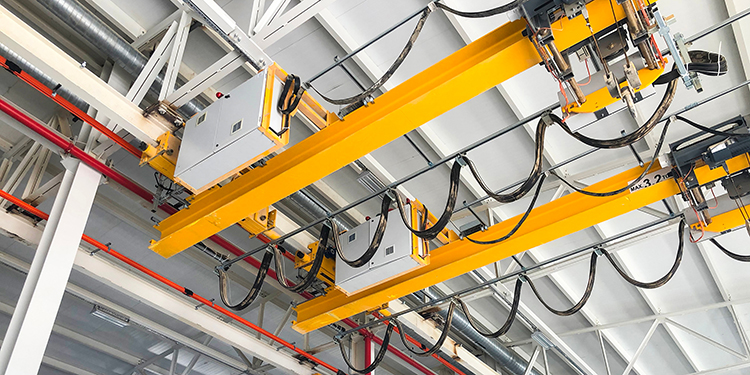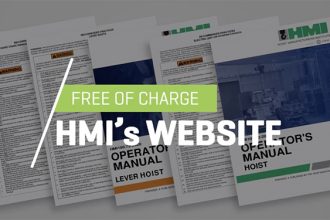11 Crane Components That Enhance Safety, Reliability And Ease Of Maintenance

While nothing replaces thorough and continuous training (and re-training) of workers on how to safely operate overhead single and double girder crane equipment, there are several key components that can be engineered into cranes to enhance their overall safety, reliability and ease of maintenance. Depending on the individual application, many suppliers — including the members of MHI’s Overhead Alliance (which includes the Crane Manufacturers Association of America (CMAA), the Hoist Manufacturers Institute (HMI), and the Monorail Manufacturers Association (MMA)) — can include one or more of these 11 different components.
All three industry groups are a part of the Occupational Safety and Health Administration’s (OSHA) Crane, Hoist and Monorail (CHM) Alliance. Through this collaboration, the organizations provide information, guidance and access to training resources that help protect the health and safety of worker using hoists, cranes and monorails, including a fact sheet that details these specific components, which include:
- Horns. These audible warning devices are ideal for congested areas where standard strobe lights may not be visible to all personnel due to obstructions in their field of view. They produce a sound that alerts employees when a load is being moved. Cranes equipped with radio controls, or those that are cab-controlled, are required to have horns by OSHA 29 CFR 1910.179, the standard for overhead and gantry cranes.
- Warning Lights. Colored, flashing or strobe lights that visually alert surrounding personnel of a moving load, warning lights are also required by OSHA 29 CFR 1910.179 for cab-controlled cranes.
- Crane Lights. These lights are affixed to the underside of an overhead crane to provide illumination and greater visibility of the floor and other potential obstructions beneath it as it moves. The larger the crane, the more likely the facility is to benefit from the additional lighting, because bigger cranes tend to block out more ceiling lights.
- Collision Avoidance Systems. These systems monitor the location of each crane on a runway and keep them separated to ensure that they do not collide with one another, with end stops, or with other obstructions.
- Walkways. These surfaces are added to a crane to give maintenance personnel access to the system and its components. They do not, however, replace the need for technicians to be outfitted with fall protection — such as a harness and lanyard fall arrest system — and for an additional employee to monitor the area from the ground to ensure the safety of persons working on the equipment overhead.
- Limit Switches. These devices are pre-programmed with set limits for slowing and stopping the crane’s movement as it approaches a specific point on the runway. They prevent damage to the crane and the runway by preventing it from running full speed into end-stops. Further, they help alert operators to the crane’s position as it approaches a stopping point or other obstacle.
- Overload Sensors. The latest systems offer a display panel that informs the operator of the actual load weight being lifted. Data captured also supports troubleshooting by maintenance and service technicians.
- Variable Speed Drives. Smoothly accelerating and decelerating as the crane moves, these devices reduce mechanical wear on components while removing the effect of impact loads on drive trains. This also prevents a load from swinging excessively due to a hard start or sudden stop.
- Brake Slip Monitoring. These devices document any occurrence of a brake slipping and alert maintenance personnel when adjustment is needed.
- Radio Control. By allowing an operator to maintain a safe distance from the load without being tethered to the crane by pendant control, the newest radio frequency (RF) based controls enhance safety, particularly in areas where an operator could become trapped between the load and another obstacle. Today’s models now offer two-way communication. This enables the device to both send commands to the receiver on the crane, as well as receive data transmitted back from the crane.
- Runtime Monitoring. Today’s cranes are increasingly equipped with data collection devices that store a variety of operating data from sensors incorporated into the equipment. Monitored and collected information can include load histograms, including the magnitude of the load, duration of travel, contactor switch functions, operation and total operating hours for the individual motions. Once downloaded, the information can be used to schedule more accurate timing of required maintenance activities, as well as help to determine when the useful life of the equipment has been reached.
What other benefits can your operation gain by deploying overhead handling technologies? MHI’s Overhead Alliance has produced a free publication, “Expand Your Possibilities. Discover the Potential. Choose Overhead Lifting.” It details 13 different ways overhead lifting equipment benefits manufacturing and distribution operations.



